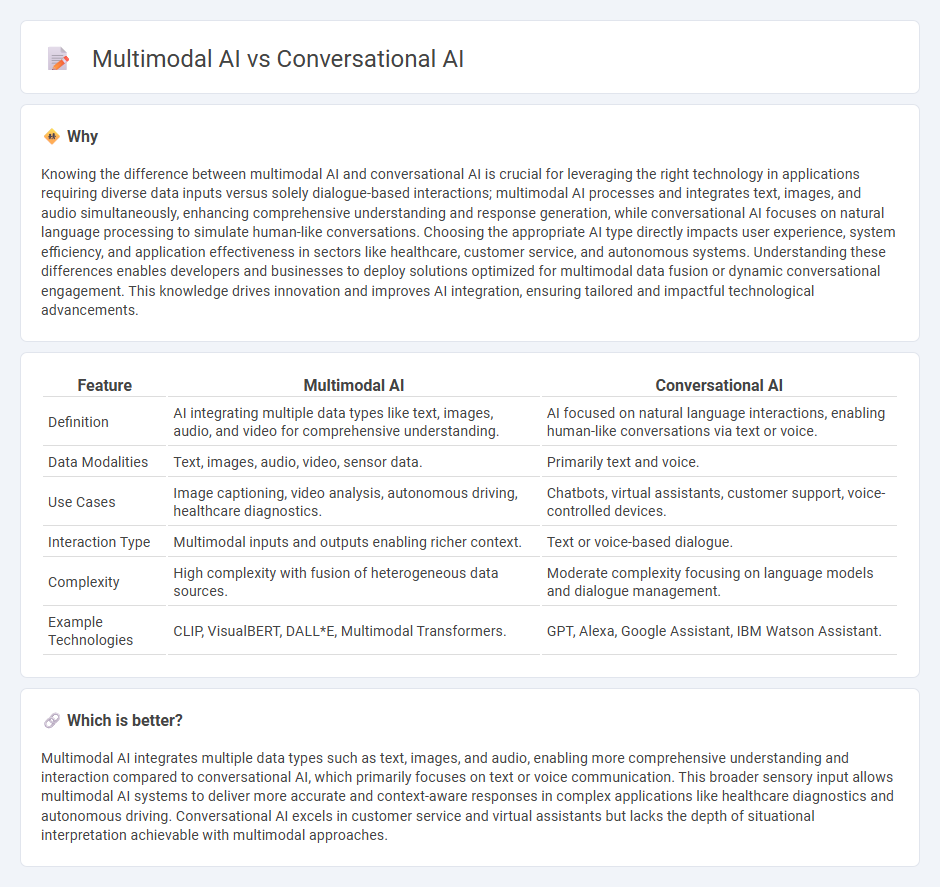
Multimodal AI integrates diverse data types such as text, images, and audio, enabling systems to interpret and respond to complex inputs more holistically than traditional models. Conversational AI specializes in natural language processing and generation, focusing primarily on dialogue-based interactions through text or speech. Explore the nuances and applications of these AI paradigms to understand their transformative impact on technology.
Why it is important
Knowing the difference between multimodal AI and conversational AI is crucial for leveraging the right technology in applications requiring diverse data inputs versus solely dialogue-based interactions; multimodal AI processes and integrates text, images, and audio simultaneously, enhancing comprehensive understanding and response generation, while conversational AI focuses on natural language processing to simulate human-like conversations. Choosing the appropriate AI type directly impacts user experience, system efficiency, and application effectiveness in sectors like healthcare, customer service, and autonomous systems. Understanding these differences enables developers and businesses to deploy solutions optimized for multimodal data fusion or dynamic conversational engagement. This knowledge drives innovation and improves AI integration, ensuring tailored and impactful technological advancements.
Comparison Table
| Feature | Multimodal AI | Conversational AI |
|---|---|---|
| Definition | AI integrating multiple data types like text, images, audio, and video for comprehensive understanding. | AI focused on natural language interactions, enabling human-like conversations via text or voice. |
| Data Modalities | Text, images, audio, video, sensor data. | Primarily text and voice. |
| Use Cases | Image captioning, video analysis, autonomous driving, healthcare diagnostics. | Chatbots, virtual assistants, customer support, voice-controlled devices. |
| Interaction Type | Multimodal inputs and outputs enabling richer context. | Text or voice-based dialogue. |
| Complexity | High complexity with fusion of heterogeneous data sources. | Moderate complexity focusing on language models and dialogue management. |
| Example Technologies | CLIP, VisualBERT, DALL*E, Multimodal Transformers. | GPT, Alexa, Google Assistant, IBM Watson Assistant. |
Which is better?
Multimodal AI integrates multiple data types such as text, images, and audio, enabling more comprehensive understanding and interaction compared to conversational AI, which primarily focuses on text or voice communication. This broader sensory input allows multimodal AI systems to deliver more accurate and context-aware responses in complex applications like healthcare diagnostics and autonomous driving. Conversational AI excels in customer service and virtual assistants but lacks the depth of situational interpretation achievable with multimodal approaches.
Connection
Multimodal AI integrates multiple data types such as text, images, and audio to enhance understanding, while conversational AI utilizes this integrated data to create seamless human-computer interactions. The synergy between multimodal AI and conversational AI enables more natural and context-aware dialogue systems by leveraging diverse sensory inputs. Advances in deep learning and natural language processing drive this connection, improving virtual assistants, chatbots, and interactive applications.
Key Terms
Conversational AI:
Conversational AI utilizes natural language processing and machine learning to enable human-like interactions through text or voice, enhancing customer service, virtual assistants, and chatbots. It specializes in understanding context, intent, and sentiment to provide accurate and personalized responses across various platforms. Explore how Conversational AI transforms communication and drives business efficiency.
Natural Language Processing (NLP)
Conversational AI leverages Natural Language Processing (NLP) to enable human-like interactions through text and speech, focusing on understanding and generating coherent dialogue. Multimodal AI integrates NLP with other data types such as images, audio, and video, enhancing context comprehension and response accuracy across diverse sensory inputs. Explore deeper insights to understand the evolving capabilities and applications of NLP within these AI paradigms.
Dialogue Management
Conversational AI primarily relies on natural language processing and dialogue management systems to understand and respond to user inputs in text or speech form, enabling seamless human-computer interaction. Multimodal AI integrates multiple data modalities such as text, voice, images, and video, enhancing dialogue management by providing richer context and more accurate responses based on diverse sensory inputs. Explore deeper insights into how these technologies revolutionize communication by improving dialogue management in AI systems.
Source and External Links
Conversational AI: What It Is and How It Works - DevRev - Conversational AI uses natural language processing, machine learning, and natural language understanding to enable chatbots and voice assistants to comprehend and respond to human language in a natural, personalized manner, enhancing customer support and engagement.
What is Conversational AI? - AWS - Conversational AI technology allows software to understand and respond to voice or text conversations like a human, providing 24/7 personalized customer support, improving operational efficiency, and increasing accessibility.
What is Conversational AI? | Salesforce US - Conversational AI is an advanced AI technology that mimics natural human dialogue, evolving from basic chatbots to sophisticated agents capable of reasoning, learning, and taking actions with minimal human oversight across sales, service, and marketing.
 dowidth.com
dowidth.com